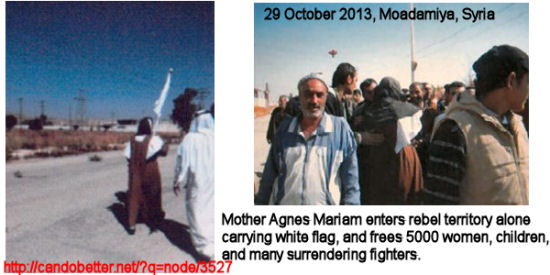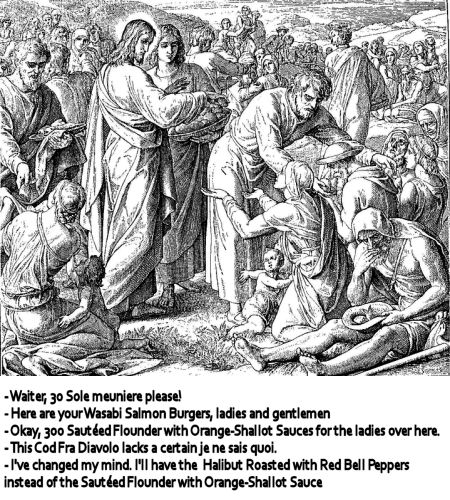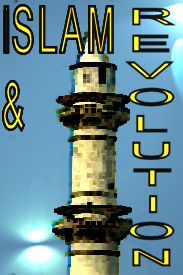Mother Agnes Mariam ON the Cross; denigration and denial of the Syrian reality
 People all over the world have been shocked to discover that Mother Agnes Mariam, heroine to many women and men all over the world and peace activist on the ground in Syria, withdrew from speaking at a UK peace conference because two British supposedly 'left-wing' male speakers and journalists - Jeremy Scahill and Owen Jones - threatened to withdraw from speaking if she spoke. Neither speaker has given any substantive explanation for their objections to Mother Agnes, but it seems that both have succumbed to propaganda that the Syrian government of President Bashar al-Assad is brutal and that Agnes Mariam supports the government. This treatment of Mother Agnes Mariam is tragically bizarre, when she has eclipsed professional peace negotiators in so many spheres at once: In her physical bravery in rescuing thousands of people in the war-torn region; as a nun-pacifist woman-leader in the male-dominated politics of church and war; and as a local peace-activist in an internationalised field of jihadists. The article below seeks to highlight just some of these injustices. See links at the end of this article, under "Notes," including a filmed interview with Mother Agnes Mariam done by Susan Dirgham of AMRIS in Australia July 2013.
People all over the world have been shocked to discover that Mother Agnes Mariam, heroine to many women and men all over the world and peace activist on the ground in Syria, withdrew from speaking at a UK peace conference because two British supposedly 'left-wing' male speakers and journalists - Jeremy Scahill and Owen Jones - threatened to withdraw from speaking if she spoke. Neither speaker has given any substantive explanation for their objections to Mother Agnes, but it seems that both have succumbed to propaganda that the Syrian government of President Bashar al-Assad is brutal and that Agnes Mariam supports the government. This treatment of Mother Agnes Mariam is tragically bizarre, when she has eclipsed professional peace negotiators in so many spheres at once: In her physical bravery in rescuing thousands of people in the war-torn region; as a nun-pacifist woman-leader in the male-dominated politics of church and war; and as a local peace-activist in an internationalised field of jihadists. The article below seeks to highlight just some of these injustices. See links at the end of this article, under "Notes," including a filmed interview with Mother Agnes Mariam done by Susan Dirgham of AMRIS in Australia July 2013.
A few weeks ago, following months of siege in a suburb of Damascus, over 5000 civilians were helped to safety during a ceasefire negotiated by Mother Agnes Mariam of the Cross. This suburb of Moadamiya al Sham was one of several around Damascus held by armed rebel groups and foreign jihadists, with the residents trapped there and facing serious food and supply shortages.
Whether these residents were supportive of the 'revolution' - or insurgency - or not, it was in the rebel groups interests to hold them there as 'human shields'; negotiating their release. Movement to the safety of government shelters in Damascus was therefore fraught with difficulties and dangers.
Mother Agnes risked life and got 5,400 people released from rebel capture

A 'negotiating team' was assembled to go into the heart of rebel territory, led by Mother Agnes - not just figuratively. She went ahead with a white flag, risking her life and faith that a sniper would not put an end to this humanitarian mission. Joined by the rest of the team she then came to a reconciliation and agreement with rebel leaders on the release of some 5,400 people, mostly women and children.
While this was a great success, perhaps more significant was the voluntary surrender of over 500 'rebel fighters', who had clearly been impressed by her entreaties to give up the fight and return to 'fight for Syria', accepting the Government's offer of amnesty.
In her report on the 'rescue of Moadamiya' she emphasises that the Government for its part kept to its word, and faith - that those men who genuinely surrender will not be punished or ill-treated.
/?q=node/3527
Syria inspired
It is as though the spirit of reconciliation and peace embodied in Jesus' preachings and actions 2000 years earlier in this land is being reborn, and it is happening through the agency of people of such genuine good will and faith as Mother Agnes. Such a spirit is infectious, and others are inspired to forgive and to reconcile and to trust; this is the spirit now which can heal Syria's dreadful wounds.
Treacherous foreign powers
The spirit that could heal those wounds .... were it not for the treachery and ill-intent of foreign powers who have already invested so much in destabilising Syrian society and destroying its wealth and infrastructure with their proxy armies of fanatics and mercenaries. The regaining of control by the Syrian government threatens the whole project for regional influence and control that is the driving force behind 'the West's' behaviour over Syria. It is increasingly clear that the West has lost the battle, in the absence of military intervention.
What should the 'Western powers' do?
So what should 'We' do? How can the West stop the truth of the last two and a half years emerging? The truth behind the many 'massacres' confected to excuse Western intervention? The truth of Syrians fleeing from rebel 'liberated' areas? ("Liberated from their inhabitants," as Mother Agnes points out.) The truth of the 'Chemical Weapons attack' on Ghouta that nearly brought about a regional war, despite not a single proven victim? ( The OPCW team did no autopsies.)
Perhaps those responsible for the recent denigration of Mother Agnes Mariam were inspired by biblical history, realising that a 'betrayal' from those who would be her supporters could deliver a mortal blow. And so it came to pass that contributors to the Stop the War Peace Conference in the UK refused to share a platform with this true peacemaker.
Have we learned anything in two thousand years?
NOTES
Related material:
Richard Edmondson, "‘Investigative Journalist’ Scahill Takes Swipe at Mother Agnes" of 17 Nov 2013.
Neil Clark, Mother Agnes and the ‘liberal’ hawks out to silence her of 20 Nov 2013.
Candobetter.net's Mother Agnes Mariam pages.
Mother Agnes Mariam's letter withdrawing from the Stop the War conference (pdf, 66K).
Internet Site of the UK Stop the War Conference.

 My first conscious half hour today, Good Friday 2013, was occupied by a radio program where people rang in to talk about what fish they planned to celebrate with today.
My first conscious half hour today, Good Friday 2013, was occupied by a radio program where people rang in to talk about what fish they planned to celebrate with today.
 Here is a very topical, historical account by E.J. Hobsbawm of the rise of Islam in the so-called undeveloped world which occurred in reaction to the disruption caused by colonialism. People who are interested in why there is still apparent opposition between Western “democracy” and capitalism and Islam, might find it interesting.
Here is a very topical, historical account by E.J. Hobsbawm of the rise of Islam in the so-called undeveloped world which occurred in reaction to the disruption caused by colonialism. People who are interested in why there is still apparent opposition between Western “democracy” and capitalism and Islam, might find it interesting.
 A new website -
A new website - 
Recent comments